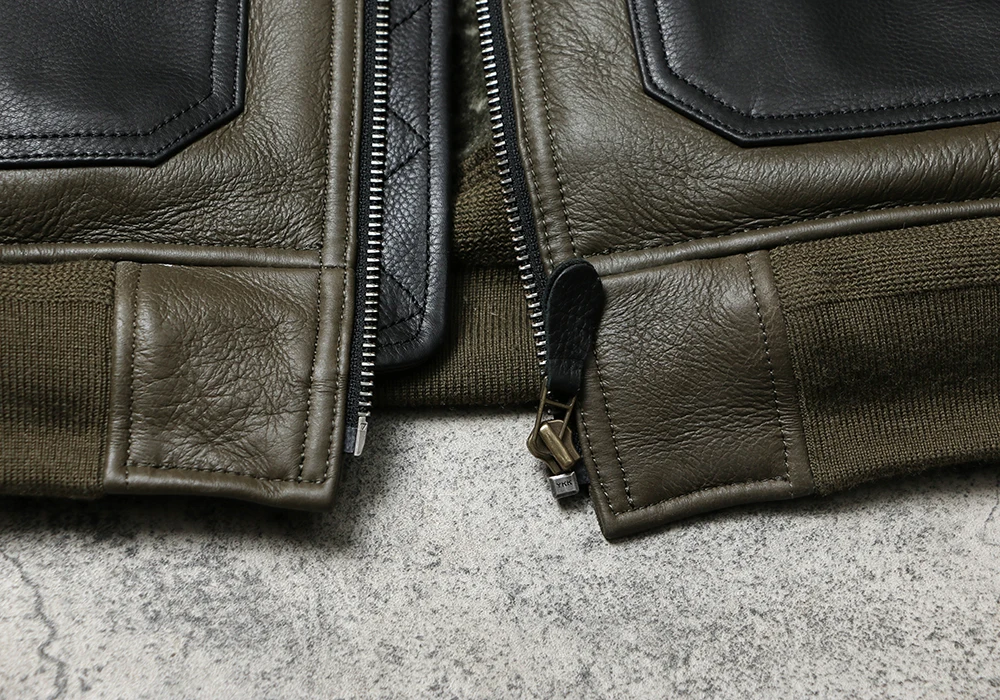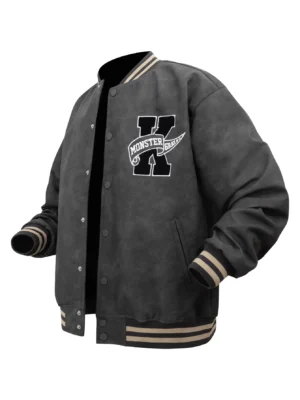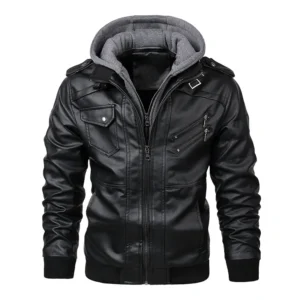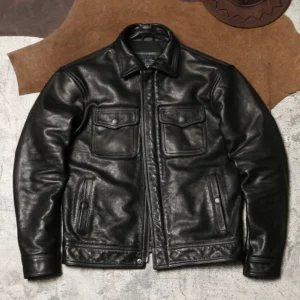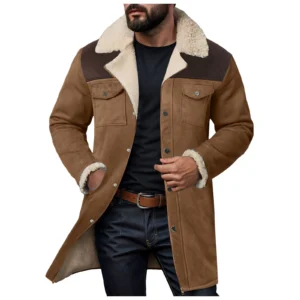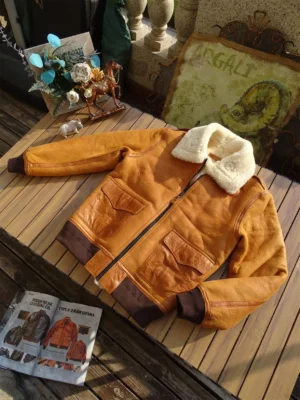Deciphering Shearling: The Soul of the Jacket
What is Genuine Shearling?
Shearling is not just any winter material—it’s a specific natural product with distinct characteristics that set it apart from ordinary textiles. Genuine shearling is sheepskin or lambskin that has been tanned with the wool still attached to the hide. This creates a material with two connected layers: a suede or leather exterior and a soft, insulating wool interior.
What makes genuine shearling special:
- It comes from a single hide—the wool and leather are naturally connected, not sewn together
- The tanning process carefully preserves both the leather’s durability and the wool’s softness
- The material breathes naturally, allowing air circulation while maintaining warmth
- Each piece has subtle natural variations, reflecting its organic origin
The tanning process is crucial for creating quality shearling. This ancient technique transforms raw sheepskin into a durable, flexible material that can last decades when properly cared for. The process must carefully balance preserving the leather’s strength while maintaining the wool’s softness and loft.
The type of sheepskin used significantly impacts the final product. Lambskin shearling (from younger animals) produces a lighter, softer garment with more supple leather, while mature sheepskin creates a more substantial, durable jacket with denser wool. This natural foundation is what allows classic shearling jackets for men to develop character over time rather than simply wearing out.
Distinguishing Real Shearling from Faux Alternatives
As synthetic alternatives become more common in the marketplace, understanding the differences between genuine and faux shearling becomes essential for identifying a truly classic piece.
Real shearling differs from synthetic alternatives in several key ways:
- Material structure: Genuine shearling has wool fibers naturally growing from the hide, while faux versions have synthetic fibers glued or sewn to a backing material
- Temperature regulation: Real shearling keeps you warm in cold weather yet remains breathable, whereas synthetics often trap moisture and feel clammy
- Tactile experience: Natural shearling has a distinctive weight and hand-feel—substantial yet supple—that synthetics struggle to replicate
- Aging characteristics: Authentic shearling develops a desirable patina and character over time, while synthetic materials typically just deteriorate
While synthetic options have improved over the years, they fundamentally lack the performance characteristics that have made genuine shearling endure as a classic material. When examining potential purchases, knowing how to tell if a jacket is authentic shearling or sheepskin helps ensure you’re investing in a genuine classic rather than a temporary imitation.
The Anatomy of a Classic: Material Quality and Craftsmanship
A. The Signature Material: Premium Sheepskin
Not all shearling is created equal. The finest classic jackets use premium sheepskin varieties, each with distinct characteristics that contribute to the garment’s quality, comfort, and longevity.
Premium sheepskin varieties include:
- Merino: Features exceptionally fine, dense wool fibers that provide superior insulation with less bulk
- Toscana: Known for its distinctive long, silky wool fibers that create a luxurious, flowing appearance
- Enterfino: Offers thicker, denser wool and a more substantial hide, creating a more structured garment
- Rasado: Derived from younger lambs, producing incredibly soft, lightweight leather with shorter wool
- Corto: Features close-cropped wool for a sleeker profile while maintaining warmth
What makes these materials exceptional is their natural performance characteristics. The structure of wool fibers creates millions of tiny air pockets that trap body heat while allowing moisture to escape. This natural insulation works in harmony with the leather exterior, which blocks wind and provides durability.
Unlike synthetic materials that trap moisture against the skin, quality shearling breathes naturally. This moisture-wicking property keeps you comfortable across a wide temperature range—a key reason why men’s sheepskin coats have remained popular despite technological advances in synthetic insulation.
The leather component of premium shearling also contributes significantly to its performance. When properly tanned, the hide becomes water-resistant yet breathable, creating a natural barrier against the elements that synthetic materials struggle to replicate.
B. The Art of Construction: Built to Endure
A truly classic shearling jacket pairs exceptional materials with meticulous construction techniques that maximize durability and comfort. This craftsmanship transforms raw materials into heirloom-quality garments.
Key construction elements include:
- Seam integrity: Double-stitched or reinforced seams prevent separation even after years of wear and movement
- Strategic paneling: Careful cutting and assembly of shearling panels accommodate natural stretch while maintaining structure
- Quality hardware: Robust zippers, genuine horn buttons, or leather toggles that complement the natural materials
- Interior finishing: Attention to detail on interior seams and pockets, often with leather binding for durability
The integrity of these construction elements directly impacts how the jacket performs over time. Proper stitching techniques allow the garment to move with the body while maintaining structural integrity. Quality hardware ensures closures continue to function properly through years of use.
While design trends may evolve, the construction principles of men’s leather shearling coats have remained remarkably consistent over decades. This continuity reflects not fashion whims but a commitment to proven techniques that maximize the material’s natural benefits and create garments that improve with age.
Iconic by Design: Timeless Silhouettes and Features
A. Enduring Cuts and Styles
The “classic” status of shearling jackets stems largely from several iconic designs that have stood the test of time. These silhouettes have remained relevant despite shifting fashion trends because they balance function, comfort, and timeless aesthetics.
The most enduring shearling styles include:
B-3 Bomber: Developed for high-altitude military pilots, featuring an oversized collar that can be folded up for neck protection, side-entry pockets, and a straight hem. Its boxy silhouette provides maximum warmth and freedom of movement.
Aviator: A close relative of the B-3, distinguished by its wider lapels that can be worn open or secured closed across the neck. Often features angled chest pockets and a slightly more tailored fit than the original bomber.
Duffle Coat: Characterized by its longer length (typically mid-thigh), toggle closures, and often a hood. The design balances formal and casual elements for versatile wear.
Reefer/Peacoat Style: Adapts the naval peacoat design with a double-breasted front, broad lapels, and a slightly shorter length. Creates a more formal shearling option.
Moto/Biker Style: Features asymmetrical zippers, notched lapels, and a more fitted silhouette. Combines the ruggedness of shearling with the edgy aesthetics of motorcycle culture.
Long Coat: Extends to knee length or below, maximizing warmth and creating a dramatic silhouette. Often features a belted waist for definition.
These designs have persisted because they successfully balance form and function. The complete history of aviator shearling jackets reveals how these garments evolved from purely utilitarian military gear to fashion statements without losing their core functionality.
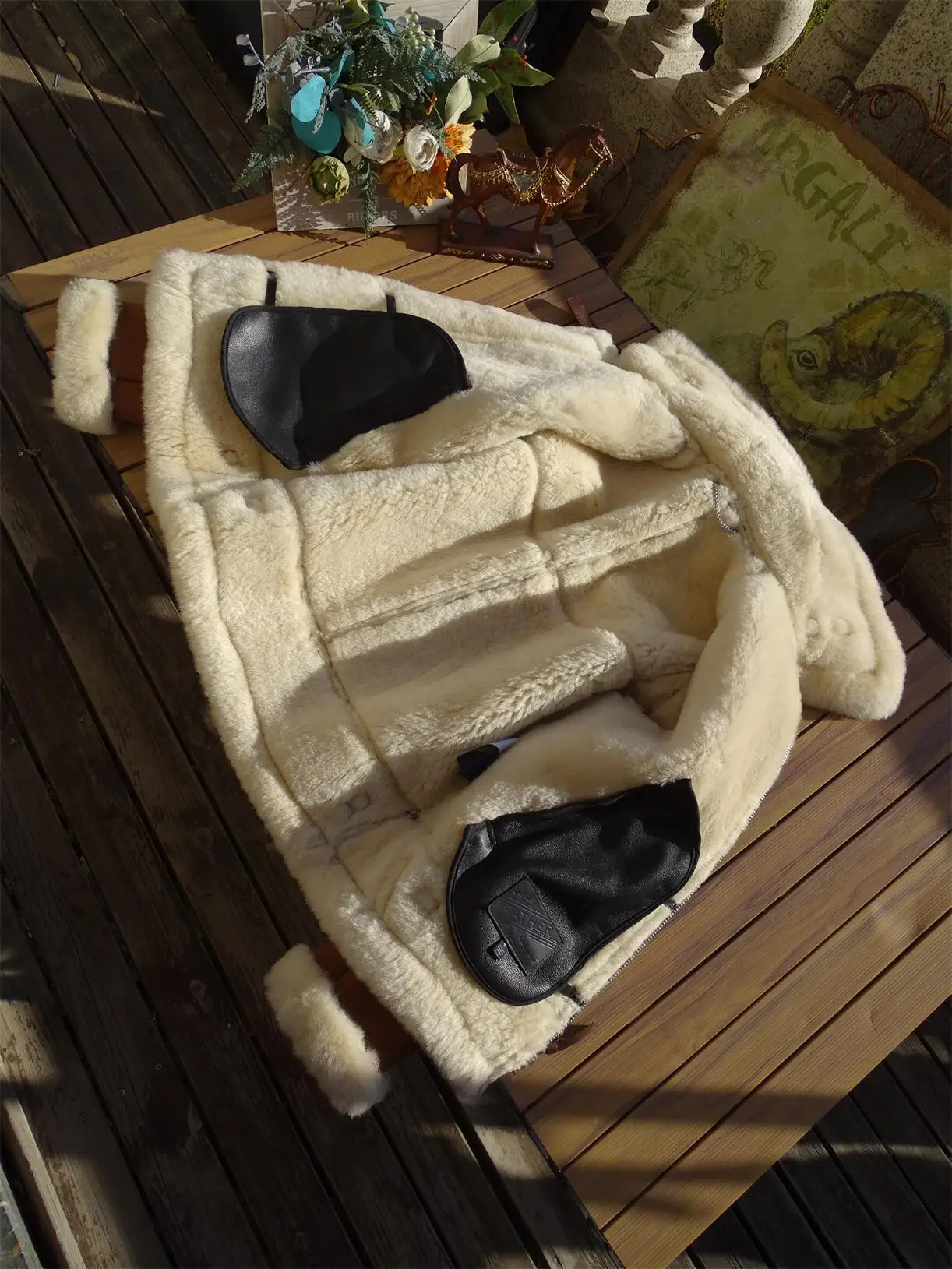
B. Signature Design Details
Beyond the overall silhouette, classic shearling jackets are defined by specific design details that contribute to both their functionality and aesthetic appeal. These elements have remained remarkably consistent over time, reinforcing their status as defining features rather than temporary embellishments.
Key design elements include:
Collar treatments: Wide, fold-up collars that protect the neck and face when secured; oversized lapels that showcase the contrast between leather exterior and wool interior
Cuff and hem finishes: Often feature exposed shearling at edges for both visual interest and additional warmth; reinforced leather binding prevents wool from stretching or fraying
Closure systems: Heavy-duty metal zippers with leather pulls; horn or leather-covered buttons; leather toggles with rope or leather loops on duffle styles
Pocket designs: Range from practical patch pockets with flaps to protect contents to streamlined welt pockets that maintain a cleaner silhouette
These design elements serve practical purposes while creating the distinctive aesthetic that makes shearling jackets immediately recognizable. The combination of exposed wool at collars and cuffs with a leather exterior creates a natural contrast that synthetic materials struggle to replicate convincingly.
Understanding these features of a timeless shearling coat helps distinguish between trendy interpretations and truly classic pieces that will remain relevant for decades.
C. The Overall Aesthetic
The enduring appeal of classic shearling jackets stems from their unique combination of rugged durability and natural elegance. This balance creates pieces that feel simultaneously substantial and refined—workwear elevated to heirloom status.
The visual and tactile contrast between the smooth or napped leather exterior and the soft, insulating wool interior creates natural visual interest. This built-in contrast eliminates the need for excessive embellishment, allowing classic designs to remain visually compelling despite their relative simplicity.
Perhaps most remarkably, classic shearling improves aesthetically with age. The leather develops a rich patina through use, becoming more supple and developing character that mass-produced garments cannot replicate. This natural aging process transforms a shearling jacket from a purchase into a personal artifact with history and stories embedded in its very fibers.
A Rich Heritage: The History Behind the Classic Status
The classic status of shearling jackets isn’t merely a matter of materials and design—it’s inseparably linked to their rich historical context and cultural significance across generations.
Shearling’s journey from practical necessity to fashion statement begins with ancient shepherding cultures, where the material provided unmatched protection against harsh weather conditions. Its natural insulation and durability made it a staple in cold-weather regions long before fashion considerations entered the equation.
The material’s modern iconic status, however, largely stems from its adoption by military aviation. As open-cockpit flying exposed pilots to extreme conditions, shearling’s exceptional warmth-to-weight ratio made it the natural choice for protective gear. During World War II, the B-3 bomber jacket and similar designs became standard issue for high-altitude crews facing temperatures as low as -50°F at altitude.
The post-war period saw surplus military shearling jackets enter civilian markets, where their proven performance and distinctive aesthetic quickly gained popularity. Hollywood embraced the style, with screen icons wearing shearling in films that celebrated rugged individualism and adventure.
Later, countercultural movements adopted shearling for its authenticity and substance in contrast to mass-produced synthetic alternatives. From frontier settlers to military heroes to cultural icons, shearling has consistently represented authenticity, resilience, and timeless functionality.
This heritage explains why truly vintage-inspired coats continue to resonate with contemporary audiences. They connect wearers to a legacy of craftsmanship and purposeful design that transcends temporary trends.
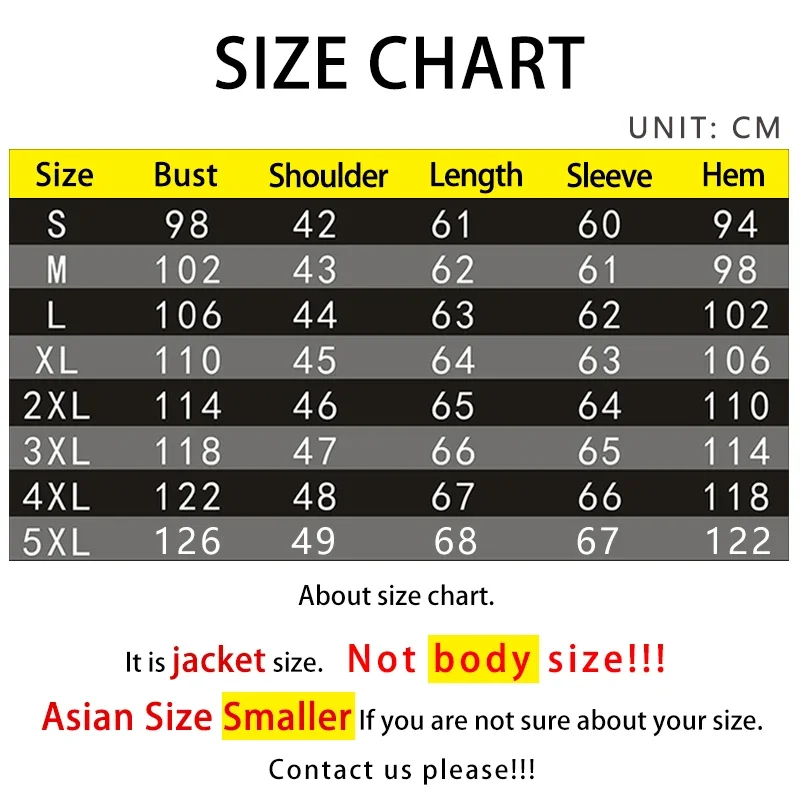
Beyond the Tangible: Why a Shearling Jacket Remains a Classic
A. Timelessness and Versatility
A defining characteristic of classic shearling jackets is their remarkable ability to remain relevant despite changing fashion landscapes. This timelessness stems from designs that prioritize function over fleeting trends, creating silhouettes that complement rather than dominate a personal style.
The versatility of classic shearling designs allows them to work across diverse wardrobe contexts:
- Paired with tailored trousers and dress boots for a refined winter look
- Combined with jeans and boots for casual weekend wear
- Layered over knitwear for practical cold-weather protection
- Worn with contemporary pieces to create interesting textural contrasts
This adaptability extends to seasonal transitions as well. Quality shearling works from early autumn through winter and into early spring, adapting to temperature changes more effectively than most synthetic alternatives.
For those seeking to maximize their investment, understanding classic shearling jacket styling options helps leverage this versatility across different settings and seasons.
B. Lasting Power and Graceful Aging
Unlike disposable fashion that quickly looks dated or deteriorates physically, quality shearling jackets improve with time and use. This graceful aging process transforms them from products into personal artifacts with unique character and stories.
The leather exterior develops a patina—subtle changes in color and texture—that reflects the wearer’s experiences. Far from being a defect, this natural evolution gives the jacket character impossible to replicate in new garments. Meanwhile, quality wool maintains its insulating properties for decades when properly cared for.
This aging process creates an emotional connection distinct from ordinary clothing purchases. A well-worn shearling jacket becomes a record of experiences and a companion through winters rather than simply a seasonal expense.
This quality aligns with growing interest in sustainable consumption—investing in fewer, better things that last rather than participating in cycles of disposal and replacement. A classic shearling jacket may cost more initially, but its decades-long lifespan represents the antithesis of fast fashion’s environmental impact.
C. The Investment Value
Understanding classic shearling as an investment rather than a purchase shifts the value calculation significantly. While quality shearling represents a substantial initial outlay, evaluating it through a cost-per-wear lens reveals its true value proposition.
A well-made shearling jacket can easily last 20+ years with proper care. When that lifespan is considered against the purchase price, the per-season or per-wearing cost becomes remarkably reasonable—often lower than repeatedly replacing lower-quality alternatives that fail after a few seasons.
Beyond practical economics, choosing a classic shearling jacket represents an investment in daily comfort and confidence. The superior performance characteristics—natural temperature regulation, weight distribution, freedom of movement—create a wearing experience that mass-produced alternatives simply cannot match.
For those concerned with long-term value, classic designs also maintain higher resale value than trendy interpretations. Well-maintained vintage shearling jackets from quality makers often sell for prices approaching their original cost, reflecting their enduring appeal and functionality.
Mens Leather Coat, Mens Long Leather Coat
Price range: $225.22 through $235.58 Select options This product has multiple variants. The options may be chosen on the product pageMens Black Leather Coat, Mens Leather Coat
Price range: $181.52 through $197.20 Select options This product has multiple variants. The options may be chosen on the product pageMens Brown Leather Coat, Mens Leather Coat
$846.94 Select options This product has multiple variants. The options may be chosen on the product pageMens Shearling Coat, Mens Sheepskin Coat
$888.08 Select options This product has multiple variants. The options may be chosen on the product page- Price range: $96.28 through $130.88 Select options This product has multiple variants. The options may be chosen on the product page
Mens Shearling Coat, Mens Sheepskin Coat
$2,257.19 Select options This product has multiple variants. The options may be chosen on the product page
Know Your Shearling: Identifying Authenticity and Quality
A. Verifying Genuine Shearling
Identifying authentic shearling becomes increasingly important as synthetic alternatives and lower-quality “shearling-like” materials flood the market. Several practical tests can help verify genuine materials:
Touch test: Authentic shearling has natural wool fibers that vary slightly in length and texture. Synthetics typically feel uniform and may have an artificial slickness.
Backing examination: In genuine shearling, the wool grows directly from the hide—there’s no separate backing material. Look at seam edges or inside pockets to verify the wool and leather are one integrated material.
Wool fiber assessment: Natural wool has a slight crimp and springiness. When gently pulled, it returns to position. Synthetic fibers often lack this natural resilience.
Weight consideration: Genuine shearling has substantial weight due to the natural hide and wool combination. Synthetic alternatives typically feel significantly lighter.
Seam and edge inspection: At raw edges, authentic shearling shows a single material layer where leather transitions to wool. Imitations often reveal separate materials joined together.
Scent evaluation: Natural shearling has a subtle leather smell, sometimes with hints of lanolin. Synthetics often have chemical odors or attempt to mask these with strong artificial fragrances.
Water test: Place a small drop of water on an inconspicuous wool area. Natural wool absorbs moisture slowly, while synthetics often repel it entirely or absorb it very quickly.
These verification methods matter because authentic materials directly impact the jacket’s performance, longevity, and comfort. Quality leather coats using genuine materials maintain their functionality and appearance far longer than synthetic alternatives.
B. Evaluating Overall Craftsmanship and Quality
Beyond material authenticity, overall construction quality determines whether a shearling jacket truly qualifies as “classic.” Several indicators help assess craftsmanship:
Seam examination: Quality pieces feature tight, even stitching with reinforcement at stress points. Inconsistent stitch length or tension indicates corner-cutting.
Panel alignment: The hide panels should be carefully matched for color and texture consistency, with strategic placement that maximizes material strengths.
Hardware quality: Zippers, buttons, and other closure systems should operate smoothly and feel substantial. Quality pieces often use branded hardware from established manufacturers.
Interior finishing: The inside construction reveals much about overall quality. Clean seam finishing, thoughtful pocket placement, and attention to detail indicate comprehensive quality control.
Brand reputation: Established makers with longstanding reputations for quality have much to lose from cutting corners. Research brand history and customer experiences.
While price often correlates with quality in shearling garments, it’s not the sole indicator. Understanding construction fundamentals helps identify exceptional value regardless of price point.
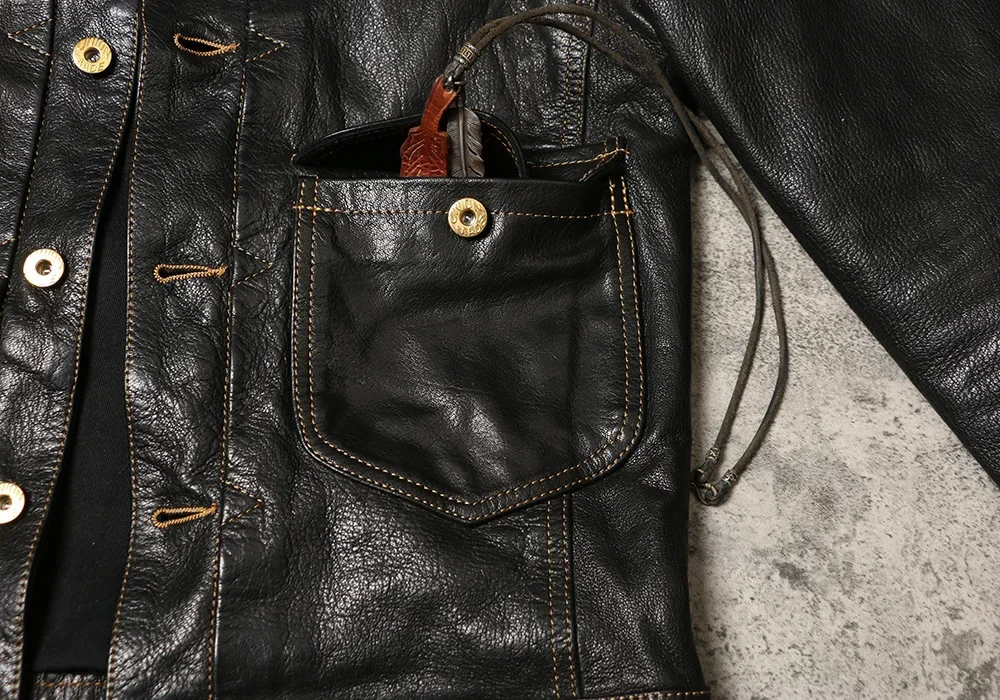
Preserving Your Investment: Care and Maintenance for Classic Shearling
Proper maintenance significantly extends the lifespan of a classic shearling jacket, transforming it from a seasonal purchase into a lifetime companion. Following these care practices ensures your investment continues performing at its best:
Routine Care:
– Gently brush the wool interior with a soft-bristled brush to remove dust and restore loft
– Allow the jacket to air out after wearing before storing
– Hang on a sturdy, wide-shouldered hanger to maintain shape
– Keep away from direct heat sources and sunlight which can dry out the leather
Moisture Management:
– Avoid wearing in heavy rain or snow when possible
– If the jacket gets wet, allow it to dry naturally at room temperature
– Never use direct heat (hairdryers, radiators) to speed drying
– For water spots on the leather, let them dry completely before addressing
Cleaning Approaches:
– Spot clean minor stains using products specifically designed for shearling
– Brush dried mud or soil away once completely dry
– For wool side cleaning, use a slightly damp cloth with minimal friction
– Seek professional cleaning for significant soiling or stains
Storage Techniques:
– Store in a breathable garment bag, never plastic
– Choose a cool, dry location away from direct sunlight
– Include cedar blocks to deter moths but keep them from direct contact with the jacket
– Ensure the jacket is completely clean and dry before seasonal storage
Understanding how to properly maintain your jacket is a crucial aspect of buying classic shearling coats that will serve you for decades. Most maintenance issues stem from improper care rather than actual wear, making knowledge as valuable as the garment itself.
The Enduring Legacy: Why the Classic Shearling Jacket Prevails
What truly defines a classic shearling jacket is not simply its material composition or construction details, but the remarkable synthesis of these elements into something greater than the sum of its parts. The classic shearling jacket represents a perfect balance of form and function—beautiful enough to be coveted yet practical enough to be genuinely useful.
The enduring appeal stems from an authentic connection to purpose. Unlike garments created primarily for fashion impact, classic shearling designs evolved to solve real problems of warmth, comfort, and durability. This honest functionality gives them a integrity that purely decorative garments lack.
The natural materials at the heart of these jackets connect wearers to ancient traditions of craftsmanship. In a world increasingly dominated by synthetic materials and automated production, the tactile pleasure of genuine shearling offers a counterpoint—something substantial and real in both literal and figurative senses.
Perhaps most importantly, classic shearling jackets tell stories. They record experiences in their gradually changing texture and appearance. They connect generations through designs that remain relevant despite changing trends. They embody a approach to consumption based on quality and longevity rather than novelty and disposal.
This combination of genuine materials, purposeful design, superior performance, and emotional resonance explains why the classic shearling jacket remains not just relevant but revered—a true icon that transcends fashion to become heritage.

